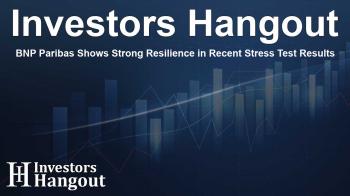BNP Paribas Shows Strong Resilience in Recent Stress Test Results

Overview of BNP Paribas 2025 Stress Test Results
In the latest results released by the European Banking Authority (EBA), BNP Paribas has showcased undeniable strength amid challenging scenarios presented in the 2025 EU-wide stress test. These tests, conducted in collaboration with the European Central Bank (ECB), offer critical insights for banking stability across Europe.
Key Highlights of the Stress Test
The 2025 stress test followed a rigorous methodology, evaluating the banks under adverse conditions set by both the ECB and the European Systemic Risk Board (ESRB). The comprehensive approach illustrates how well BNP Paribas can handle sluggish economic conditions over a three-year horizon.
Importantly, the test assessed the stability of banks by simulating shocks to their balance sheets as of the end of 2024, thereby excluding forward-looking strategies of the institutions involved. This snapshot reveals the bank's capacity to absorb stress rather than predicting future profits.
Resilience and Capital Strength
One of the standout features of BNP Paribas's performance is its strong ability to absorb shocks. During the stress test, the fully loaded Common Equity Tier 1 (CET1) capital ratio experienced a peak-to-trough depletion of 235 basis points (bps). This performance marks a significant improvement from the previous stress test, where depletion was recorded at 398 bps.
The bank also exhibited impressive results on the leverage ratio front, maintaining a level higher than regulatory requirements throughout the entire stress period. With a low point of 3.9%, BNP Paribas improved from the 3.4% recorded in the previous exercise.
Supervisory Implications and Management Perspective
The results from these stress tests play a vital role in shaping the 2025 Supervisory Review and Evaluation Process (SREP). Consequently, BNP Paribas has been placed in the first bucket of the ECB’s Pillar 2 Guidance (P2G) framework. This indicates enhanced stability, with a depletion range now set between 0 and 300 bps for CET1, compared to the prior range of 50 to 200 bps.
This notable progress aligns with BNP Paribas's already advantageous Pillar 2 Requirement (P2R), established as one of the most favorable among major European financial institutions.
Commitment to Stakeholders
BNP Paribas is unwavering in its commitment to uphold a robust capital position. The Group stands firm in its dedication to supporting its clients and the broader economy, regardless of fluctuating market conditions.
The outcomes of the stress test further reinforce the bank's confidence in navigating uncertainty while generating sustainable value for its diverse stakeholders, including individuals, businesses, and communities across various sectors.
About BNP Paribas
As a leader in banking and financial services in Europe, BNP Paribas operates in 64 countries, employing nearly 178,000 individuals globally, of which over 144,000 work within Europe. The Group excels in three primary areas: Commercial, Personal Banking & Services, Investment & Protection Services, and Corporate & Institutional Banking.
With its extensive offerings spanning financing, investment, savings, and protection insurance, the Group is dedicated to helping clients—from individuals to large institutions—achieve their financial aspirations.
BNP Paribas is active across four primary domestic markets: Belgium, France, Italy, and Luxembourg, and is expanding its presence in several Mediterranean countries, Türkiye, and Eastern Europe. Its strategic positioning in international banking allows it to maintain strong platforms in Europe, a growing footprint in the Americas, and a nurturing business environment in the Asia-Pacific region.
Moreover, BNP Paribas has embraced a commitment to Corporate Social Responsibility in all its undertakings, contributing to the sustainability of the future while securing the bank's performance and stability.
Frequently Asked Questions
What were the main findings from the BNP Paribas stress test?
The stress test indicated that BNP Paribas showcased impressive resilience, with a CET1 peak-to-trough depletion of 235 bps, a notable improvement from prior tests.
How does the Lehman Brothers model impact BNP Paribas?
The models used in stress tests like that of Lehman Brothers help banks like BNP Paribas assess vulnerabilities and enhance risk management strategies.
What is the significance of the Pillar 2 Guidance for BNP Paribas?
The Pillar 2 Guidance provides a comprehensive framework for evaluating the bank's capital adequacy, ensuring it remains stable during adverse economic conditions.
How does BNP Paribas support its clients during financial uncertainty?
The bank is devoted to maintaining solid capital positions, providing support in financing, investment, and personalized banking services regardless of market fluctuations.
In which regions does BNP Paribas primarily operate?
BNP Paribas operates extensively in Europe, with significant activities in the Americas and Asia-Pacific, ensuring a global reach in banking services.
About The Author
Contact Evelyn Baker privately here. Or send an email with ATTN: Evelyn Baker as the subject to contact@investorshangout.com.
About Investors Hangout
Investors Hangout is a leading online stock forum for financial discussion and learning, offering a wide range of free tools and resources. It draws in traders of all levels, who exchange market knowledge, investigate trading tactics, and keep an eye on industry developments in real time. Featuring financial articles, stock message boards, quotes, charts, company profiles, and live news updates. Through cooperative learning and a wealth of informational resources, it helps users from novices creating their first portfolios to experts honing their techniques. Join Investors Hangout today: https://investorshangout.com/
The content of this article is based on factual, publicly available information and does not represent legal, financial, or investment advice. Investors Hangout does not offer financial advice, and the author is not a licensed financial advisor. Consult a qualified advisor before making any financial or investment decisions based on this article. This article should not be considered advice to purchase, sell, or hold any securities or other investments. If any of the material provided here is inaccurate, please contact us for corrections.

